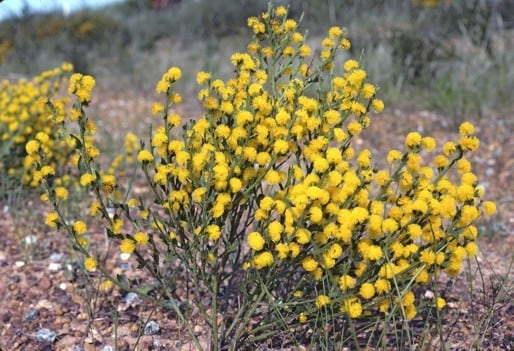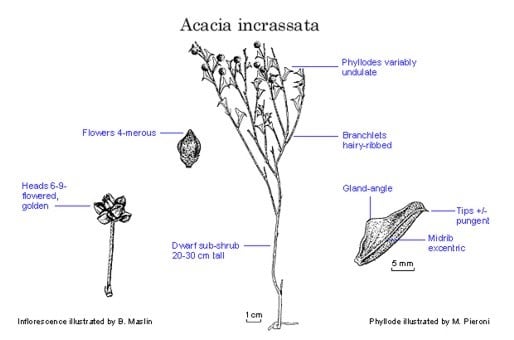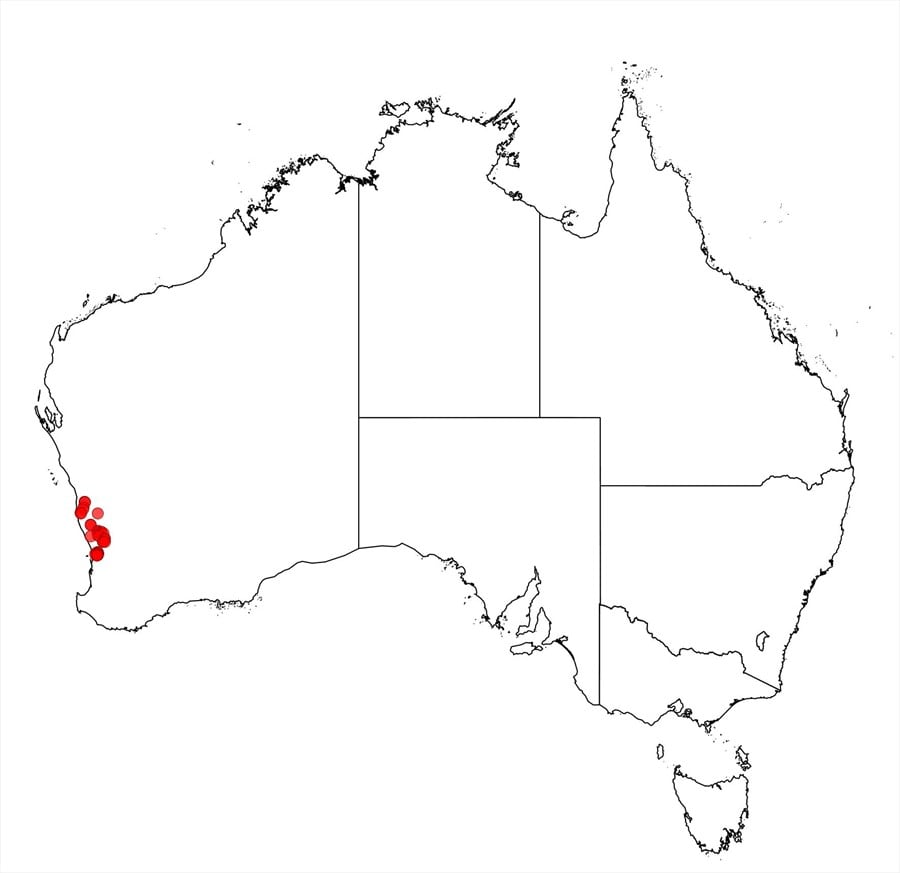Acacia incrassata Hook.
WATTLE
Acacias of Australia
Family
Fabaceae
Distribution
Occurs in south-western W.A. from the Mt Lesueur area S to Kalamunda and also presumably from Serpentine (syntype of A. vernicosa, n.v.); a variant occurs near Watheroo.
Description
Subshrub 15–30 cm high, spreading by subterranean runners. Branchlets prominently ribbed, normally appressed-puberulous, but hairs sometimes sparse and mostly confined to ribs. Stipules indurate, sometimes spinose, 1.5–3 mm long. Phyllodes inequilateral, usually obtriangular to obdeltate with a prominent gland-bearing angle on adaxial margin above the middle, obliquely truncate, with adaxial proximal margin often ±congruent with branchlet, 5–12 mm long, 4–10 mm wide, ±undulate, ±pungent, often slightly shiny, glabrous to sparsely puberulous; midrib prominent and near abaxial margin. Inflorescences apparently simple, normally 1 per axil; peduncles 4–8 mm long, appressed-puberulous, sometimes subglabrous; heads globular, usually 6–9-flowered, golden; bracteoles acuminate; buds abruptly constricted at apices, acute. Flowers 4-merous; sepals 1/2–3/4-united, with triangular lobes. Pods narrowly oblong, shallowly curved, to 5 cm long, 4–5 mm wide, crustaceous, glabrous; margins thickened. Seeds longitudinal, oblong-ovate, shiny, greenish grey; aril small.
Habitat
Grows in lateritic loam in Wandoo (Eucalyptus wandoo) woodland or in sand or loamy gravel in low heath.
Specimens
W.A.: 1.5 km NW of Mt Lesueur, E.A.Griffin 1964 (PERTH); Reserve no. 35499, SE of Eneabba, E.A.Griffin 3159 (PERTH); Kalamunda, R. & M.Hamilton 120 (PERTH); 6.8 km N of Mogumber on road to Moora, B.R.Maslin 4489 (MEXU, PERTH).
Notes
A specimen from 11.1 km N of Watheroo (R.J.Cumming 1619, PERTH) is atypical in its larger than normal, 15–18-flowered heads and its unusually shaped phyllodes with the gland-angle below the middle.
Recognised by its dwarf habit, ribbed, hairy branchlets, phyllode shape, golden heads of normally 6–9 flowers and acuminate bracteoles. Possibly most closely related to A. chrysocephala, a member of the ‘A. biflora group’.
FOA Reference
Data derived from Flora of Australia Volumes 11A (2001), 11B (2001) and 12 (1998), products of ABRS, ©Commonwealth of Australia
Author
B.R.Maslin
This identification key and fact sheets are available as a mobile application:
URL: https://apps.lucidcentral.org/wattle/
© Copyright 2018. All rights reserved.










